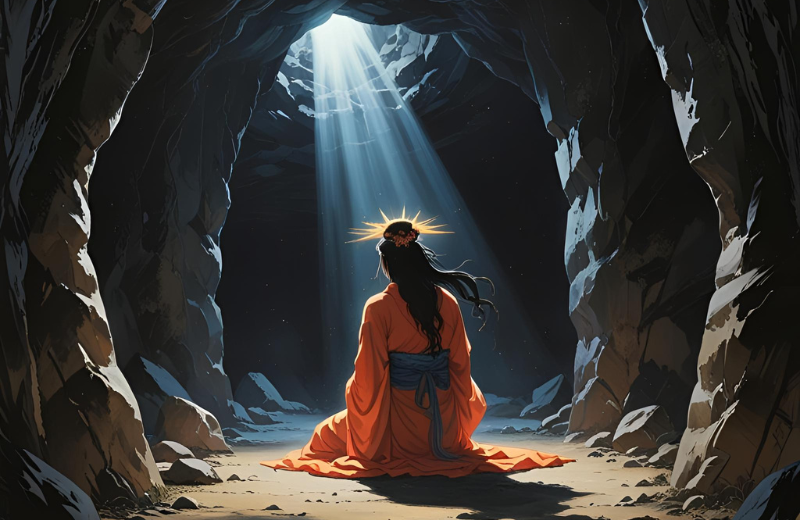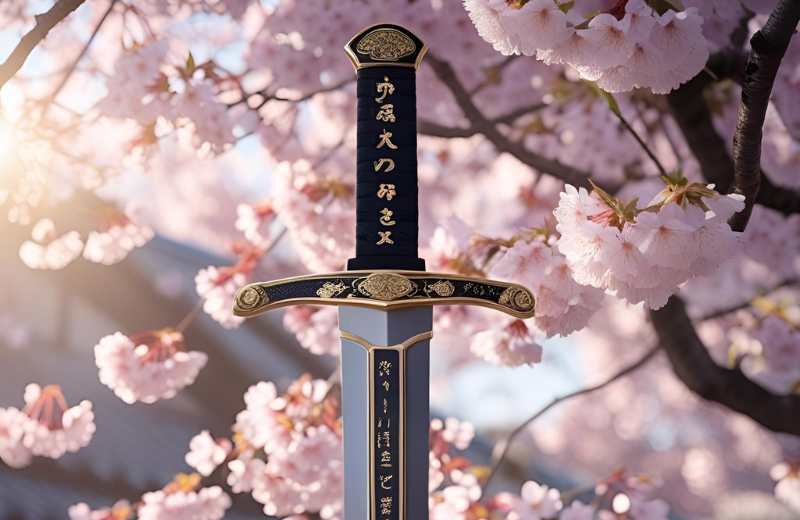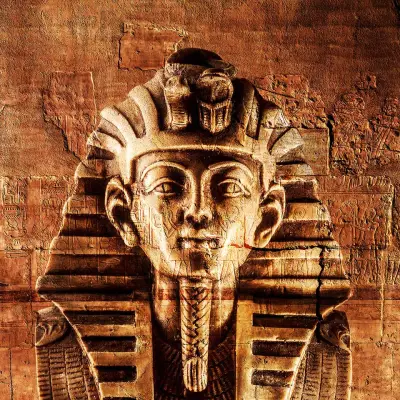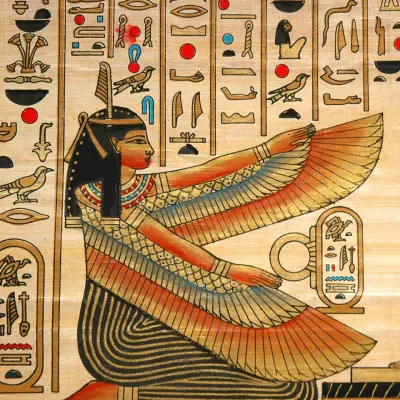If you’ve ever looked into Japanese mythology, you’ve probably come across the radiant figure of Amaterasu. Often called the Japanese sun goddess, she’s one of the most important deities in the Shinto religion and continues to play a powerful role in Japanese culture today.
Let’s explore who this divine figure is, the myths surrounding her, and what she represents in modern-day culture.
Jump to:
- Who Is Amaterasu in Japanese Mythology?
- Amaterasu’s Myths
- The Role of Amaterasu in Japanese Storytelling
- What Powers Did Amaterasu Possess?
- Symbols Associated with Amaterasu
- Amaterasu’s Lineage and Connections
- Why Is Amaterasu Special?
- Amaterasu in Modern Culture
- Amaterasu’s Worship and Legacy
- Frequently Asked Questions About Amaterasu
- Study Japanese Mythology for £29
Recommended for you!
Best SellersWho Is Amaterasu in Japanese Mythology?
Amaterasu, also known as Amaterasu-ōmikami, is the Japanese goddess of the sun and one of the central figures in Shinto mythology. Her name roughly translates to “Shining in Heaven”, which reflects her connection to light and the celestial world. Her meaning is rooted in her role as the bringer of light, warmth, and life to the world.
She’s believed to have been born from the left eye of the creator god Izanagi during a ritual purification, and her siblings include Tsukuyomi, the moon god, and Susanoo, the storm god. Together, they form a divine triad in Japanese mythology, although their relationships are often marked by conflict.
Amaterasu’s Myths

The stories surrounding Amaterasu offer insight into the beliefs and values of Shinto tradition. Here are three popular myths that feature her:
The Cave of Darkness
One of the most well-known myths tells of Amaterasu retreating into a cave after a violent conflict with her brother, Susanoo, the storm god. After he desecrated her sacred weaving hall and frightened her attendants, Amaterasu withdrew from the world, causing the sun to disappear and plunging everything into darkness.
The gods, desperate to bring light back, gathered outside the cave and performed a joyful dance. They placed a mirror on a tree and made so much noise that Amaterasu peeked out, only to be captivated by her own reflection. As she stepped out, sunlight returned, symbolising the restoration of balance and harmony.
The Creation of the Imperial Line
In another significant myth, Amaterasu sends her grandson, Ninigi-no-Mikoto, down to Earth to rule over the human world and bring peace. She gifts him with three sacred treasures: the mirror (symbol of wisdom), the sword (symbol of strength), and the magatama jewel (symbol of benevolence).
This act establishes the divine right of Japan’s emperors, who are said to descend from Ninigi, and strengthens Amaterasu’s role as the source of royal legitimacy. The myth highlights her position as both a celestial ruler and a divine matriarch.
The Rivalry with Tsukuyomi
Another tale speaks of the fractured relationship between Amaterasu and her brother Tsukuyomi, the moon god. After Tsukuyomi killed the goddess of food for an offence Amaterasu did not condone, she was so repulsed by his actions that she separated from him permanently.
This cosmic split is used to explain why the sun and the moon never appear in the sky together. The story reflects the Shinto view that harmony among the gods is essential to the natural order, and how conflict can lead to lasting divisions in the heavens.
The Role of Amaterasu in Japanese Storytelling
In Japanese storytelling, Amaterasu-ōmikami represents order, stability, and the nurturing force of light. She’s not just the Japanese sun goddess; she’s also viewed as the progenitor of the Imperial Family of Japan. According to legend, the emperors are her direct descendants, granting them divine status.
Her character is depicted as calm, wise, and motherly, in contrast to the brashness of Susanoo or the cool aloofness of Tsukuyomi. This contrast helps illustrate the balance of elements in Shinto beliefs: light and dark, sun and moon, order and chaos.
What Powers Did Amaterasu Possess?

Amaterasu's powers are radiant and nurturing, reflecting her role as the Japanese goddess of the sun and guardian of harmony and order.
- Light and Illumination: As the Japanese sun goddess, Amaterasu brings sunlight to the world, enabling life to flourish and driving away darkness both physically and spiritually.
- Growth and Agriculture: Her presence ensures the changing of the seasons and the success of crops, connecting her to fertility and abundance.
- Divine Authority: Amaterasu is regarded as the ancestress of the Japanese Imperial Family, giving her the sacred power to rule and maintain balance in the heavens and on Earth.
- Spiritual Guidance: She represents purity and truth, acting as a moral compass and offering clarity and enlightenment to followers.
- Harmony and Peace: In Shinto belief, Amaterasu fosters cooperation among the gods and inspires human beings to seek order over chaos.
Symbols Associated with Amaterasu

Symbols of Amaterasu reveal her grace, wisdom, and celestial influence. These emblems help express her role as a divine protector and bringer of light.
- The Yata no Kagami (Eight-Span Mirror): This sacred mirror was used to lure Amaterasu from her cave and is a powerful symbol of truth, reflection, and wisdom.
- The Rising Sun: Representing her light, power, and life-giving energy, the rising sun symbol is often associated with Amaterasu-ōmikami and appears prominently on the Japanese flag.
- The Magatama Jewel: This comma-shaped jewel symbolises protection, divine authority, and spiritual power, forming part of the Imperial Regalia.
- The Sacred Sword (Kusanagi): Though more directly linked to her descendant, it forms part of the treasures she bestowed, representing courage and divine favour.
- The Colours Gold, Red, and White: These hues reflect her radiant nature: gold for sunlight, red for power and vitality, and white for purity and divinity.
Amaterasu’s Lineage and Connections
Amaterasu Omikami is the daughter of Izanagi, the god who created the islands of Japan. Her divine status is reinforced by her role as the ancestor of Emperor Jimmu, the first Emperor of Japan, linking her directly to the Imperial line.
She’s the sister of Tsukuyomi, the moon god, and Susanoo, the storm god. These family dynamics are key to many of the myths in Amaterasu mythology, particularly the tension between herself and Susanoo.
Although she did not marry in traditional myths, she did send her grandson, Ninigi-no-Mikoto, to Earth to bring peace and order, beginning the lineage of the Japanese emperors.
Why Is Amaterasu Special?
What sets Amaterasu apart from other Japanese gods of the sun is her enduring cultural presence. She stands for the heart of the nation, the continuity of tradition, and the balance between nature and civilisation.
Her worship continues in the famous Ise Grand Shrine, one of the most important Shinto sites in Japan, which is rebuilt every 20 years in a ritual of renewal. This ongoing reverence demonstrates that she remains a living symbol of Japan’s spiritual identity.
Amaterasu in Modern Culture

Today, Amaterasu remains a special figure in both spiritual practice and popular media. In modern Shinto belief, she’s still worshipped at grand shrines such as Ise Jingu, where rituals are performed to honour her divine presence. Her influence also extends into contemporary spirituality, where she’s embraced as a symbol of light, clarity, purity, and the divine feminine. Those who feel drawn to her often incorporate imagery of the sun, mirrors, or radiant gold into altars and rituals dedicated to guidance, truth, and renewal.
Beyond traditional practices, Amaterasu’s mythology has been adapted and reimagined across various forms of media. In the popular video game Ōkami, Amaterasu appears as a majestic white wolf who restores beauty and balance to a corrupted world using a celestial brush.
She also appears in other video games like Smite, where gods from various mythologies battle in arena-style gameplay, and Naruto, where the name Amaterasu is used for a powerful flame-based technique, though this version is more symbolic than literal.
In modern art and literature, Amaterasu is often portrayed as a serene and radiant goddess, cloaked in golden light or stepping out of her cave, a motif that resonates with themes of emergence, healing, and hope. Her story continues to inspire works that explore self-discovery, empowerment, and the restoration of harmony in dark times.
Amaterasu’s Worship and Legacy
For those who wish to honour Amaterasu, there are various ways to connect with her spiritual essence. Spending time in sunlight, especially at dawn, is considered a way to align with her energy, as is meditating on themes of renewal, guidance, and inner light. Offerings may include polished mirrors, rice, pure water, or items in her colours, to symbolise warmth, clarity, and purity.
Creating a sacred space with sun motifs or natural elements can serve as a focal point for reflection or prayer. While the ancient rites once performed in her honour at imperial shrines are rarely practised outside priestly circles today, many still feel a personal bond with her as a protector of peace, a bringer of enlightenment, and a symbol of divine femininity.
Her legacy endures, too, in national identity, reflected in the Japanese flag, known as the Hinomaru, and in the continued tradition of rebuilding her shrine at Ise every 20 years.
Recommended for you!
Best SellersFrequently Asked Questions About Amaterasu
What does Amaterasu mean?
The name translates as “Shining in Heaven,” reflecting her role as the solar deity and ruler of the sky. It emphasises her divine light and her importance as a life-giving force in Japanese belief.
Who did Amaterasu marry?
Amaterasu didn’t marry in traditional myths, but sent her descendants to Earth to rule in her name. Her grandson, Ninigi-no-Mikoto, was tasked with establishing peace and order on Earth on her behalf.
Is Amaterasu a boy or a girl?
Amaterasu is female, often described as maternal, wise, and radiant. Her femininity symbolises nurturing energy and the sustaining warmth of the sun.
Can anything stop Amaterasu?
Only Amaterasu’s own withdrawal stopped the light of the sun. She was coaxed out by cleverness and community spirit, not force. This shows her power is not easily overcome and that harmony, not conflict, restores balance.
What is the sacred animal of Amaterasu?
The sacred animal most commonly linked to Amaterasu in modern culture is the white wolf, though in ancient texts this is not confirmed. This association likely stems from creative interpretations in popular media and folklore.
What is the Greek equivalent of Amaterasu?
The closest equivalent would be Helios or Apollo, both sun gods in Greek mythology. Like Amaterasu, they embody the sun’s journey across the sky and its life-giving energy.
What is the kanji for Amaterasu?
天照 — pronounced Amaterasu, meaning “shining heaven”. These characters are commonly used in shrines and sacred texts dedicated to her.
Who is the rival of Amaterasu?
Amaterasu’s main adversary is her brother, Susanoo, the storm god, though he’s also part of her cosmic balance. Their contrasting personalities highlight the dynamic between chaos and harmony in Shinto stories.
What is Amaterasu’s full name?
Amaterasu’s full name is Amaterasu-ōmikami, meaning “The Great Divinity Illuminating Heaven”. This full title reflects the deep reverence in which she is held within Shintoism.
Study Japanese Mythology for £29
Interested in exploring more about ancient Japanese beliefs, traditions, and divine figures like Amaterasu? The Introduction to Japanese History and Culture Diploma Course from Centre of Excellence is the perfect place to start. For a discounted price of £29, you'll learn about he spiritual stories, practices, and philosophies that shaped Japan’s past and continue to influence it today.












